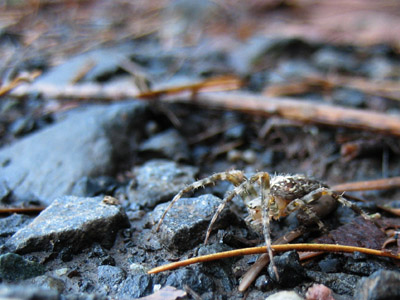Archive for the 'nature' Category
Fungophobia
Monday, November 12th, 2007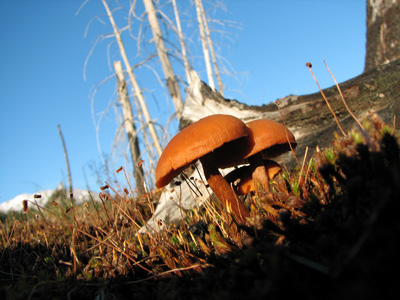
We found an abundant crop of these little brown mushrooms in Washington last week. I have no idea what they are, but I know what they’re not. Don’t worry we didn’t eat them. There are only a few dangerous mushrooms in our area and one of them is small and brown like this. The Deadly Galerina (Galerina autumnalis) is similar to one pictured above, but that doesn’t matter because you are unlikely to be collecting anything even remotely like it. Like most collectors, I usually don’t bother to collect or identify small mushrooms that I don’t plan to eat anyway unless they are exceptionally beautiful.
There are only two species which are likely to be an issue. Pholioto mutabilis is not a popular edible in part because it looks a lot like the Deadly Galerina and other mildly poisonous LMBs. More importantly it lacks a reputation as a choice edible so it will only attract the true hard core enthusiasts who want to try everything. These enthusiast are, by their very nature, knowledgeable enough to do so safely.
The mildly hallucinogenic Psilocybe stuntzii attracts more attention than P. mutabilis for obvious reasons. I don’t have any experience with it, but it is widely reported to have been found side by side with G. autumnalis. That sounds like a high risk high, but they are easily distinguished by the color of the spores. If you choose to collected Psilocybe stuntzii make a spore print of every mushroom and discard any that fail to print (and, of course, those that have cinnamon brown prints).
Some people have asserted that you could mistake a Deadly Galerina for a Candy Cap (Lactarius fragilis). However, the Lactarius genus is one the easiest genuses to identify and L. fragilis does not grow on wood. In reality, you’d have to be particularly dense to make this mistake and I have never heard of a case.
The Italian tradition has it that any mushroom growing on wood is safe and good to eat. This might be true in Italy, but not in North America. G. autumnalis being an obvious counter example.

Amanita phalloides. Santa Cruz Mountains, California 2002
Amanita phalloides (Death Cap) causes more poisonings and deaths than any other mushroom found in North America. It is very distinct and incredibly common in California. The deadliness of this mushroom has nothing to do with amateur mushroom hunters confusing it with an edible species. The problem stems from Volvariella volvacea (Paddy-straw mushroom), a similar looking edible commonly collected in Cambodia, Laos, and Vietnam. It seems like every year or two a southeast asian immigrant family poisons themselves when they discover what they think are Paddy-straw mushrooms from home. Unfortunately, it often kills half the family. In 2004, I noticed that state and local parks around the bay area began putting up signs translated in to all the southeast asian languages warning people about the Death Cap.
Interestingly A. phalloides is not native to North America. It was probably brought in with soil attached to the roots of trees imported from Europe (norway spruce and cork).
The admonishment against collecting button stage mushrooms originates with Amanita ocreata (Destroying angel) and it’s close relatives. Prized edibles like Amanita calyptrata (Coccora) and Amanita velosa (Springtime amanita) can be difficult to distinguish form A. ocreata in the button stage. However, better advice would be: Learn to identify the genus Amanita before attempting to collect and eat any mushroom with gills. Then don’t consider eating any Amanita until until you have sufficient experience to identify all the most common Amanitas on sight.
I don’t have a good picture of a destroying angel. However, it is easy to recognize because it is pure white. Do not eat any pure white amanita.
The scary part:

All of the poisonous mushrooms mentioned contain the same poisons known as amatoxins. The mortality rate is about 50% and either way it is extremely unpleasant. Symptoms don’t start until it’s too late for standard poison remedies like induced vomiting or a stomach pump. There is no antidote but massive injections of penicillin might help. The only “cure” is a liver transplant.
Cases usually progress like this: Within a few hours the toxins start causing irreparable liver and kidney damage asymptomatically. Within 10-24 hours you start to get flu like symptoms including violent vomiting, diarrhea, and abdominal cramping. These are so severe that you might check yourself into a hospital even if you don’t suspect the mushrooms. After a couple days you start to recover. You feel better and the doctor lets you go home from the hospital. Another day later you relapse. Your liver fails and you go into a coma or die. Even if you survive it is unlikely that you will recover full health.
Ape Cave (pregnant spelunking)
Tuesday, November 6th, 2007“The longest continuous lava tube in the continental United States.”
You may remember Cheyenne’s response when CJ invited us caving last summer; “no belly crawls.” Of course, in true CJ fashion, we ended up facing a tube crawl belly flop into a mud puddle before our eyes had even adjusted to dark. So when Hans suggested we visit Ape Cave up in Washington you can imagine her skepticism. Hans assured us that he had been there before. “It’ll even be okay for my diminutive dog.”
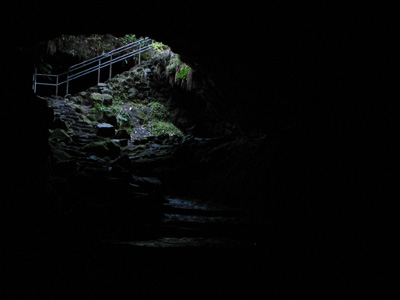
The cave entrance is in the middle and you have two choices. South leads 3/4 of a mile through a relatively flat floored open tube for non-belly-crawling, standing head room, pregnant lady-friendly spelunking. North leads one and a half miles on a grueling, stooped over, climb the underground lava flow, “challenging” hike. The main disadvantage to the southern route is that it is a dead end. Making it an equal mile and a half round trip, whereas the northern route leads to a far exit in the woods and a return surface trail.
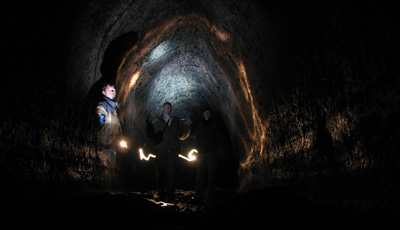
The narrowest part of the southern tube.
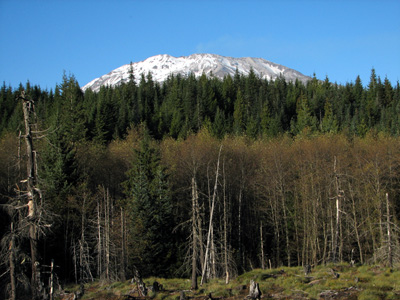
The south face of Mount St. Helens from a meadow near the cave.
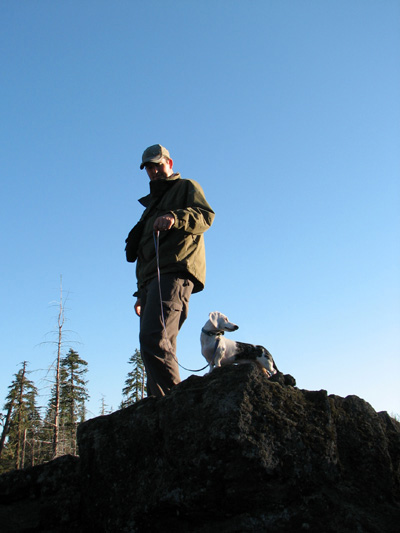
No dogs allowed, so the Hungarian Weasel Hound spent the afternoon trapped in the car.
St. Johns Bridge
Monday, November 5th, 2007
Portland, Oregon
We received a few complaints about missing updates. I looked into it and found that the email notification system broke a while back; probably when I upgraded WordPress. It should be working again now and you’ll have bit of sunshine in your Monday morning spam. All of you on the subscrition list that only read when you get something in your inbox should go back and see everything you missed. You can always see all the posts in reverse chronological order at the root page (sv-timemachine.net). It only shows 5 posts at a time, but you can keep going back by hitting the little previous button in the lower left corner.
Speaking of spam, I finally followed through on some advice Brad gave me some months ago. Have gmail pop all your mail from your spamy accounts and forward it back to you somewhere else. Actually, gmail now supports pop and imap so you can even skip the forwarding part. The spam is just gone. I love it. Google is evil! Google is great!
I’m hoping you mouse over the image.
Boletivores
Wednesday, October 31st, 2007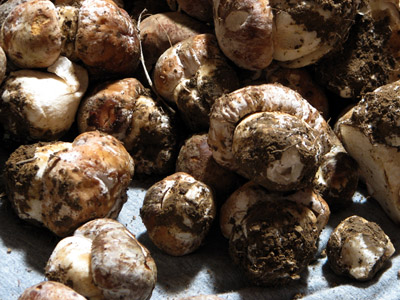
Washington County, Oregon (800×600)
Hans and I stumbled across these at twilight and ended up crawling through the brush in the dark digging them up by flashlight. We’re calling them Boletus aereus (Queen Bolete) even though we discovered them in a thicket of fir trees. Otherwise, it could be some mutant form of Boletus edulis with whitish bloom on the cap. Or it could be an as yet unnamed species. We can tell you they are very yummy and skirt the whole issue by calling them porcini or cep. Common names just don’t require the same precision.

The pilot light alone provides just enough heat and air circulation to dry mushrooms perfectly and fill the house with the earthy smell of porcini.
Cheyenne and I went back this morning to make sure we didn’t miss any. There were a few, but Hans and I had done pretty well on the first pass.

An easy one for the fungal taxonomist (Amanita muscaria).
